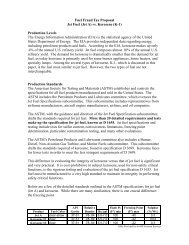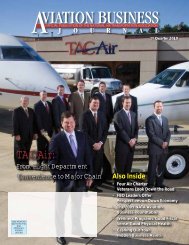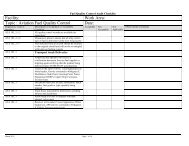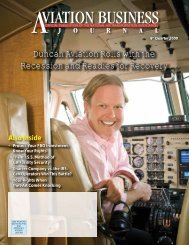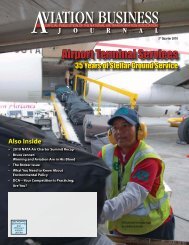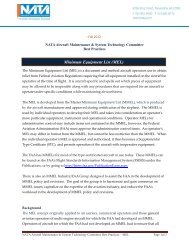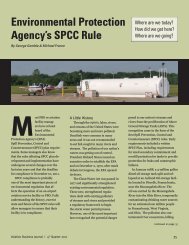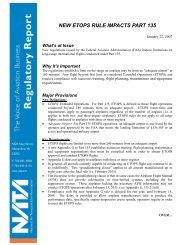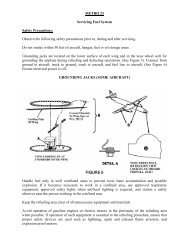Create successful ePaper yourself
Turn your PDF publications into a flip-book with our unique Google optimized e-Paper software.
<strong>Mazzei</strong> <strong>Flying</strong> <strong>Service</strong><br />
Continued from page 31<br />
“It will have to happen,” he said. “A large number<br />
of pilots are reaching the mandatory 65-year-old<br />
retirement age, and as they retire, the first thing the<br />
airlines will do is to look at the pool of furloughed<br />
pilots under 65. But once the furloughed pilots are<br />
hired back, the U.S. airlines will find that there are<br />
very few people left beyond that because the number<br />
of domestic pilots being trained in recent years<br />
is just about nil.”<br />
Citing <strong>Mazzei</strong> <strong>Flying</strong> <strong>Service</strong> as an example, Brannan<br />
reported that in 2005 and 2006 the school was<br />
training 25 to 30 flight instructors annually. “Given<br />
today’s economy, I am lucky to train five a year.<br />
This shows you where the industry is right now,” he<br />
said.<br />
Brannan also predicts that American carriers will<br />
soon be competing for pilots with a growing number<br />
of foreign-based national and international carriers<br />
that offer better pay and benefits. “For the pilot<br />
who is training here and would like to leave the<br />
U.S., there will be a lot of good opportunities among<br />
the foreign carriers,” he said. “That’s one of the reasons<br />
I predict that over the next 10 to 11 years there<br />
will be a very serious pilot shortage in this country,<br />
and in the next few years the domestic air carriers<br />
will have to seriously face the problem or start cutting<br />
service.”<br />
While Brannan is confident that the flight training<br />
industry will recover, he believes growth will<br />
be relatively slow until the airlines acknowledge<br />
the coming pilot shortage. “For now, it’s easier and<br />
more profitable for us to concentrate on training<br />
international students until the domestic airline<br />
industry wakes up,” he said.<br />
New Challenges in California<br />
In addition to the economic issues impacting the<br />
entire aviation industry, <strong>Mazzei</strong> <strong>Flying</strong> <strong>Service</strong><br />
faces a more localized challenge, as do all other<br />
flight training academies in California. Under new<br />
legislation passed last year by the State legislature<br />
and signed into law by the governor, flight schools<br />
were to be regulated under the same rules that the<br />
state imposes on private, for-profit post-secondary<br />
schools. Brannan said that before the enactment<br />
of the law, California flight schools were exempted<br />
under a letter of agreement between the State’s<br />
Bureau of Private Postsecondary Education (BPPE)<br />
and the FAA.<br />
“We were never consulted or even notified that<br />
this rule was pending until it was signed into law,<br />
and once it was, we found that compliance is impossible<br />
for most flight schools,” Brannan said. “We<br />
calculated it would cost us in access of $60,000 per<br />
year in fees and other expenses to comply. Frankly,<br />
the law as written has the potential to destroy our<br />
entire industry by shutting down every flight school<br />
and flight instructor in the state.”<br />
But thanks to a long-running effort by <strong>NATA</strong>, the<br />
Aircraft Owners and Pilots Association, and other<br />
associations, the California legislature provided<br />
at least some temporary relief to the industry. On<br />
October 8, the legislature passed SB856, which will<br />
delay compliance with the new BPPE regulations<br />
for all flight training facilities and activities, retroactively<br />
from July 2010 through July 2011. The<br />
legislation will allow the necessary time for the<br />
California legislature to examine the appropriateness<br />
of incorporating flight training into the BPPE’s<br />
regulatory purview and will give the flight training<br />
community an opportunity to have its voice heard<br />
on regulations affecting the future of the industry.<br />
“<strong>NATA</strong> has truly done a wonderful job of working<br />
with our industry and the legislature to get us some<br />
relief from the unintended consequences of this<br />
legislation,” Brannan said.<br />
Despite the current challenges, <strong>Mazzei</strong> <strong>Flying</strong><br />
<strong>Service</strong>, a Depression Era start-up, is likely to be<br />
better positioned for the future, given its reputation<br />
for quality training built up over the last 75 years.<br />
As Brannan stated, “We are very proud of our past<br />
and present achievements in training and preparing<br />
thousands of pilots for successful airline careers.”<br />
32 Aviation Business Journal | 4 th Quarter 2010



